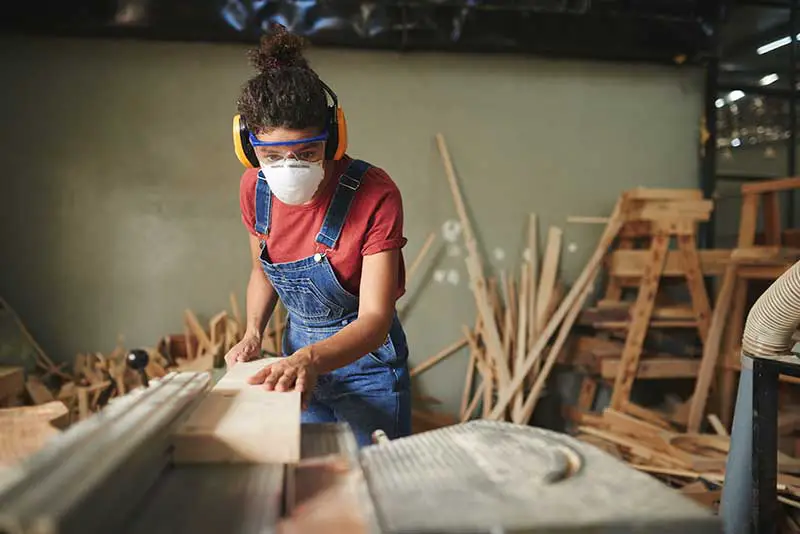Learn how to prevent kickback on a table saw with essential safety tips and techniques, including using a riving knife, proper blade height, and avoiding using the fence and miter gauge simultaneously.

Table saw kickback is a dangerous and common hazard that woodworkers face when using a table saw. Understanding the causes of kickback and implementing proper safety measures can help prevent accidents and ensure a safer woodworking environment. In this comprehensive guide, we will discuss the causes of kickback, provide essential safety tips, and outline various techniques to help prevent kickback on a table saw.
What is Kickback on a Table Saw?
Kickback occurs when a workpiece is suddenly and forcefully thrown back toward the operator during a cut. This can happen for various reasons, such as the workpiece pinching the blade, the blade binding, or the woodworker losing control of the material. Kickback can cause severe injuries, damage to the table saw, or damage to the workpiece.
Causes of Kickback
Understanding the causes of kickback is the first step in preventing it. Some common causes of kickback on a table saw include:
- Pinching the blade: When a workpiece pinches the back of the saw blade, it can cause the blade to bind and propel the workpiece back towards the operator.
- Improper alignment: Misaligned rip fence or miter gauge can cause the workpiece to bind against the blade or fence, increasing the risk of kickback.
- Dull or damaged blade: A dull or damaged blade can make it difficult for the blade to cut through the material, causing the workpiece to bind and kick back.
- Inadequate control of the workpiece: If the woodworker loses control of the workpiece during a cut, it can lead to kickback.
8 Essential Safety Tips to Prevent Table Saw Kickback
1. Use a Riving Knife
A riving knife is a crucial safety feature on a table saw designed to prevent kickback. It is a thin piece of metal mounted behind the saw blade, which maintains a consistent distance from the blade during a cut. The riving knife prevents the workpiece from pinching the back of the blade, reducing the risk of kickback. Ensure that your table saw is equipped with a riving knife and that it is properly installed and adjusted.
2. Maintain a Sharp Blade
A sharp blade is essential for smooth, efficient cutting and reducing the risk of kickback. Dull or damaged blades can cause the workpiece to bind, increasing the likelihood of kickback. Regularly inspect your blade for damage or dullness and replace or sharpen it as needed.
3. Ensure Proper Blade Height
Setting the proper blade height is crucial for reducing the risk of kickback. The blade should extend just above the top of the workpiece, minimizing the exposed blade surface. This also helps to control the workpiece better during a cut.
4. Use the Fence and Miter Gauge Appropriately
Avoid using the fence and miter gauge simultaneously when making crosscuts. Doing so can cause the workpiece to bind between the blade and fence, increasing the risk of kickback. Instead, use a crosscut sled or other suitable methods for making crosscuts.
5. Keep the Table Saw Clean and Free of Debris
A clean table saw surface is essential for maintaining control of the workpiece during a cut. Keep the table saw surface free of dust, debris, and any other obstructions that could interfere with the workpiece’s movement.
6. Regularly Inspect and Maintain Your Table Saw
Keep your table saw in good working condition by inspecting it regularly for wear and tear, loose components, or damaged parts. Replace or repair any faulty components immediately.
7. Use a Splitter
If your table saw does not have a riving knife, consider using a splitter instead. A splitter serves a similar function by preventing the workpiece from pinching the back of the blade, although it does not move up and down with the blade like a riving knife does.
8. Wear Appropriate Safety Gear
Always wear safety glasses, hearing protection, and a dust mask when operating a table saw. This not only protects you from potential injuries but also helps you maintain focus and awareness.
Additional Tips for Preventing Kickback
- Use push sticks or push blocks when making narrow cuts, as they provide better control over the workpiece and keep your hands away from the blade.
- Never stand directly behind the blade when operating a table saw. Instead, stand slightly to one side to reduce the risk of injury in case of kickback.
- Avoid using twisted, warped, or wet lumber, as it can be more challenging to control and is more prone to kickback.
- Install anti-kickback pawls or featherboards to help hold the workpiece down and guide it through the cut, minimizing the risk of kickback.
- Take your time and avoid rushing when making cuts, as this can lead to loss of control and increased risk of kickback.
By understanding the causes of kickback and implementing these safety measures, you can significantly reduce the risk of kickback on a table saw and create a safer woodworking environment.
